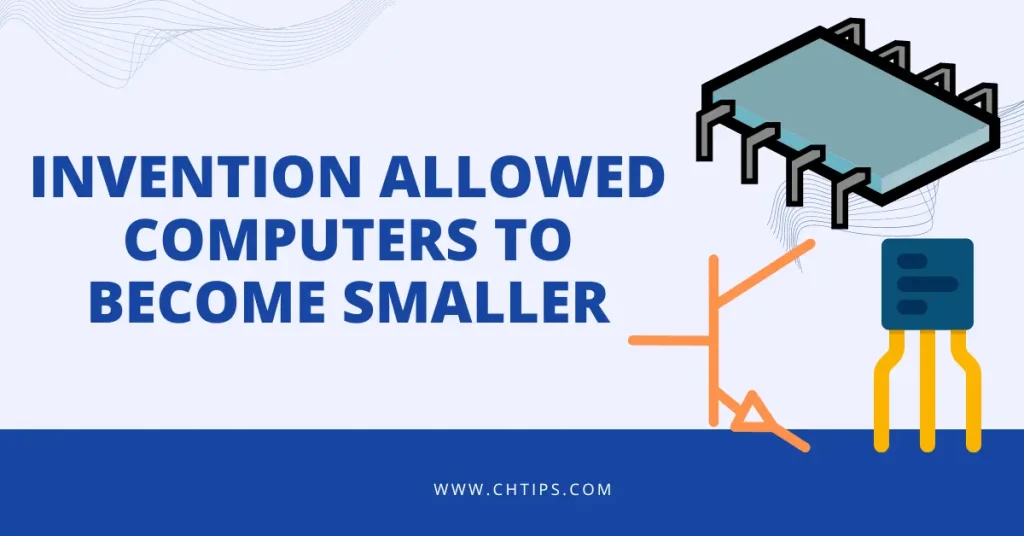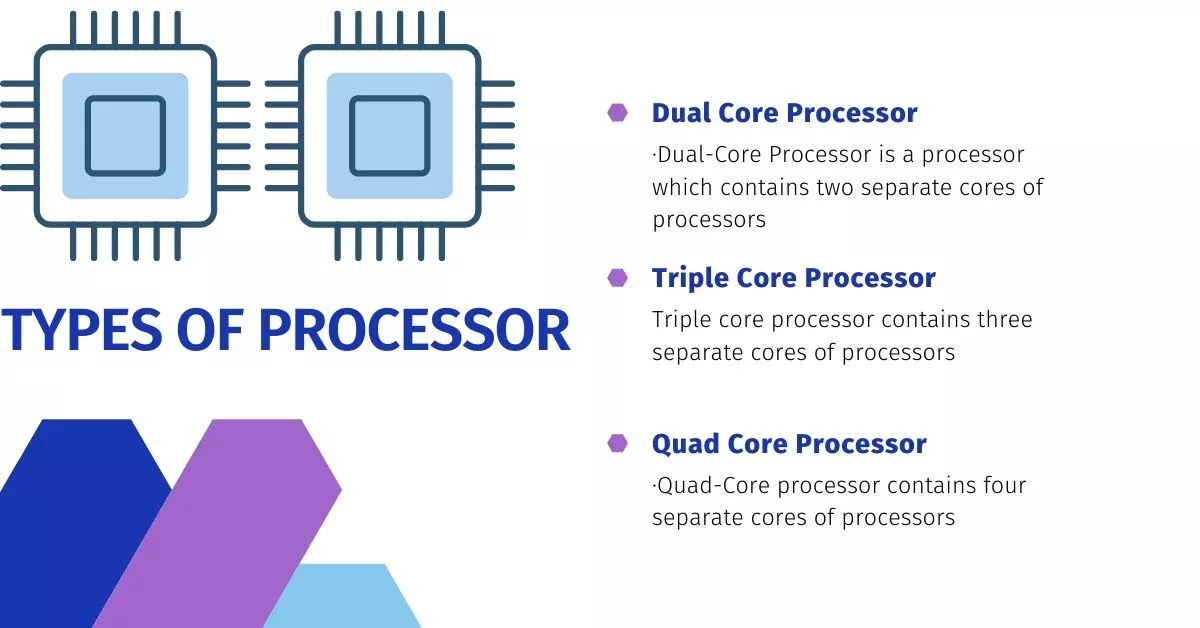If you are searching for which invention allowed computers to become smaller in size and shape? You are in the right place.
Various electronic components | computer hardware devices make computers smaller in size and more efficient compared to old-fashioned computers.
Some of such devices and components are mentioned below.
- Transistors.
- Integrated Circuit [IC].
- Microprocessor.
These components or devices play a vital role in making computers compact in shape and size.
The invention of the transistor was a stepping stone in computer and electronic history as it revolutionized the entire computer industry.
The invention of the transistor allowed computers to become smaller in size.
The transistor is a tiny device that controls the flow of electricity through a circuit and makes it possible for electronic devices to operate at low voltages.
The invention of the transistor in 1947 was one of the most critical developments in the history of electronics.
The transistor allowed computers to become smaller, faster, and more powerful.
It enabled them to become miniaturized enough for deployment in mobile devices like smartphones and tablets.5
The tiny chip inside these devices is called a processor or Microprocessor (the name depends on size).
The role of a processor is to take information from memory chips (which store data) and process it into something useful — such as text or images on your screen.
Important Components Launched Date
| # | Components | Launched Date |
| 1 | Vacuum Tubes | 1915 |
| 2 | Transistors | 1947 |
| 3 | Integrated Circuit | 1958 |
| 4 | Microprocessor | 1969 |
Which Invention Allowed Computers to Become Smaller in Size

What is Transistor
Three physicists, John Bardeen, Walter Brattain, and William Shockley, developed the first transistor at AT&T Bell Labs in 1947.
They also won a Nobel prize for their contribution in their respective fields.
The invention of transistors allowed computers to become smaller and more powerful.
A transistor is a device that allows electrical current to flow through it, but only when there’s enough voltage on both sides of the device.
Transistors are used and utilized in most electronic devices and applications in the modern world.
The transistor is a critical invention that allowed computers to become smaller and more powerful. Transistors quickly replaced Vacuum tubes due to their significant characteristics and features.
Therefore, second generations of computers used and utilized transistors in their circuitry, making them compact and more powerful than the first generations of computers.
Transistors are small electronic devices used as switches or amplifiers in electronic circuits.
They act like on/off switches when turned on but behave like variable resistors when turned off (like an LED light bulb).
Transistors allow smaller circuit boards and less space between components than previous technologies, making it possible for computers to run faster and more efficiently.
Different Types of Transistors
The transistors are divided into three different types, which are included below.
- Bipolar Transistors (Bipolar Junction Transistors: BJTs)
- Field-Effect Transistors (FETs)
- Insulated-Gate Bipolar Transistors (IGBTs).
What is Integrated Circuit
Jack Kilby designed and developed the Integrated Circuit [IC] on 12th September 1958.
He was an electrical engineer by profession from Texas Instruments Company.
The ICs are installed on PCB {Printed Circuit Board}, also called a circuit board.
The PCB comprises a thin sheet of non-conductive material from plastic, copper, and aluminium foil.
The PCB holds all components attached to it together on a single sheet. They are also responsible for connecting all electronic components through a circuit.
An integrated circuit is a microchip that contains various other electrical components like transistors and capacitors.
The components are connected in a way that allows them to work together synchronously with each other and the outside world.
An integrated circuit (IC) is a piece of hardware that contains multiple electronic components on a single silicon chip.
The most common types include digital and analog circuits, logic circuits, and memory devices like EEPROMs and SRAMs.
Integrated circuits [ICs] are used and utilized in Third Generations of Computer Systems.
Different Types of Integrated Circuits [ICs]
Three different types of Integrated Circuit are mentioned below.
- Digital IC
- Analog IC
- Mixed-signal IC
Uses of Integrated Circuits [ICs]
- Integrated circuits are used and utilized in almost all electronic devices.
- They are also installed on mobile devices.
- They are installed in palmtops, laptops, and desktops.
- ICs are compact and hence considerably reduce the size, making the devices small in shape and size.
5 Advantages of Integrated Circuits [ICs]
- They are small in shape and size.
- ICs are readily available in the market.
- They are lightly weighted.
- They consume less amount of heat and electricity.
- They need less space for installation.
Generations of Integrated Circuits [ICs]
- Small Scale Integration [SSI].
- Medium Scale Integration [MSI]
- Large Scale Integration [LSI].
- Very Large Scale Integration [VLSI].
- Ultra Large Scale Integration [ULSI].
Explain What Microprocessors are
The Microprocessor is considered the “Brain or Heart of the Computer System”. It is the essential computer device responsible for fantastic speed with almost 100% accuracy.
Ted Hoff invented the Microprocessor.
He is also considered as “Father of Microprocessor“. Intel® 4004 became the first general purpose.
The main parts of the Microprocessor are as follows.
- Arithmetic and Logical Unit.
- Control Unit.
- Cache Memory.
The first single-layer Microprocessor was developed and designed in 1969 by INTEL CORPORATION.
The brain behind it was three engineers, Federico Faggin, Ted Hoff, and Stan Mazo, and they named it Intel 4004 Microprocessor.
Different Types of Microprocessors

- Dual Core Processor.
- Triple Core Processor.
- Quad Core Processor.
Useful Video: Transistor
Generations of Computer Systems
| # | Computer Generations | Timeline | Hardware |
| 1 | First Generation of Computer | 1940-1956 | Vacuum Tubes |
| 2 | Second Generation of Computer | 1956-1963 | Transistor |
| 3 | Third Generation of Computer | 1964-1971 | Integrated Circuit (IC) |
| 4 | Fourth Generation of Computer | 1971-1980 | Microprocessor |
| 5 | Fifth Generation of Computer | 1980- Till Now | Artificial Intelligence |
- First Generation of Computer (1940-1956)
- Second Generation of Computers (1956-1963)
- Third Generation of Computers (1964-1971)
- Fourth Generations of Computers ( 1971-To 2000)
- Fifth Generations of Computers (Present and Beyond)
Top Processor Companies
- Intel.
- AMD.
- Cyrix.
Related Articles
- Advantages and Disadvantages of Fifth Generations of Computer
- Advantages and Disadvantages of First Generation Computer
- Characteristics and Features of Third Generation Computer
- 12+ Characteristics of Fourth Generations of Computer
- Advantages and Disadvantages of Fifth Generations of Computer
- What are the Five Generations of Computer Systems?
- Explanation on a Brief History of Computers
- 10 Characteristics and Features of Second Generation Computer
- What are the Five Generations of Computer System?
- Advantages and Disadvantages of Second Generations of Computer
- Fourth Generation of Computers With Characteristics, Advantages, Examples and Uses
- 11 Advantages and Disadvantages of Third Generation of Computers
- 11 Differences Between Second Generation and Third Generation Computer
- Advantages and Disadvantages of Fourth Generations of Computer
- Differences Between Third and fourth Generation of Computers
- What is Intelligent Character Recognition
- Computer Basic Tutorials
Features and Characteristics of Second Generation of Computer That Uses Transistors
- The second-generation computer was based on transistors rather than vacuum tubes.
- They are quite reliable and user-friendly.
- They can use and process assemblies and high-level languages like FORTRAN and COBOL.
- They produce fewer amounts of heat and energy.
- As they produce heat and energy, they require Air conditioners for better cooling and performance.
- Magnetic Tape and disks are used as secondary storage.
- The Second Generation Computer System Uses Transistors for enhanced performance.
- They reduced all operational time required for processing and handling tasks and jobs.
The Second Generation Computer Was Based On
The second-generation computer was based on a transistor that replaced vacuum tubes.
Frequently Asked Questions [FAQs]
Which invention allowed computers to be smaller?
The invention of the transistor revolutionized the electronic and computer industry.
What made computers small?
Transistors and Integrated Circuits.
Who Invented Transistors Used in 2nd Generation Computers
Walter Brattain, John Bardeen, and William Shockley designed and developed the transistor.
Who Invented Integrated Circuit
Jack Kilby invented the Integrated Circuit.
Which invention helped make computers much smaller and faster?
Using and utilizing Integrated circuits [IC] made computers incredibly faster and more accurate.
Which generation of computers was the largest?
The first generation of computers used huge and bulky vacuum tubes.
What were two inventions that made computers better and smaller?
Microprocessor and Operating System.
What invention helped make computers much smaller and faster?
Microprocessor.
What invention replaced vacuum tubes and allowed computers to get smaller and much faster?
Transistors replaced bulky vacuum tubes.
What invention is a smaller faster cheaper and more durable electronic device that replaced vacuum tubes and mechanical relays?
Transistors.
Get In Touch
I have also written and compiled some articles on computers and telecommunications, and please go through them.
I hope you will like reading it.
All the questions and queries about which invention allowed computers to become smaller have been answered here.
If you have questions about transistors and their uses, with examples.
Don’t hesitate to contact me, and if you need to add, remove or update anything from the article, please let me know in the comment section or via email.
I will be more than happy to update the article. I am always ready to correct myself.
Please share this article with your friends and colleagues; this motivates me to write more on related topics.
!!! Thank You !!!